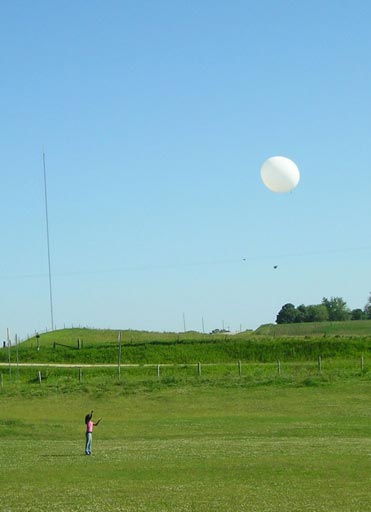Interagency Effort Will Help Dial In Carbon Profiles
Published: 30 June 2008

Beginning in June, ARM is supporting an offsite field campaign in Iowa that will obtain a variety of carbon dioxide (CO2) measurements to evaluate the accuracy, precision, and utility of CO2 profiles measured by a National Aeronautics and Space Administration (NASA) Differential Absorption Lidar (DIAL). To obtain the atmospheric CO2 measurements, the science team will deploy an ARM balloon-borne sounding system alongside a ground-based NASA CO2 DIAL, a CO2 monitoring tower sponsored by the National Oceanic and Atmospheric Administration, and a temporary mesoscale network of tower-based CO2 sensors supported by the Department of Energy (DOE). The test will evaluate the potential of the new DIAL CO2 technology for future experiments, potentially including space-based measurements.
Current CO2 observational technology is limited to either in situ or atmospheric column measurements. During the CO2 DIAL field campaign, the science team will test the ability of the CO2 DIAL system to measure (a) the difference in CO2 concentration between the atmospheric boundary layer (surface to 1 km high) and the free troposphere (up to 10 km high), and (b) weather-related variability in both free tropospheric and atmospheric boundary layer CO2 concentrations. Temperature and humidity profiles from the ARM balloone-borne sounding system will be used to convert CO2 density measured with the DIAL system into mixing ratios. For three weeks in June and July, soundings are being collected 1-2 times per day, when DIAL CO2 measurements are being collected. Daytime measurements are optimal for evaluating differences in mixing ratio between the atmospheric boundary layer (typically well-mixed by clear-air convection during the day) and the free troposphere.
DIAL has the potential to provide continuous measurements of both the atmospheric boundary layer and the free troposphere. These data would provide valuable input to atmospheric budget methods used to infer sources and sinks of CO2 by providing this continuous measure of free tropospheric mixing ratios. Interagency observations obtained during the DIAL CO2 field campaign, nested within the DOE-supported mesonet located in the study region, will be merged into the broader context of the North American Carbon Program Mid-Continent Intensive campaign.
The ARM Climate Research Facility is a DOE Office of Science user facility. The ARM Facility is operated by nine DOE national laboratories, including .
Keep up with the Atmospheric Observer
Updates on ARM news, events, and opportunities delivered to your inbox
ARM User Profile
ARM welcomes users from all institutions and nations. A free ARM user account is needed to access ARM data.


















